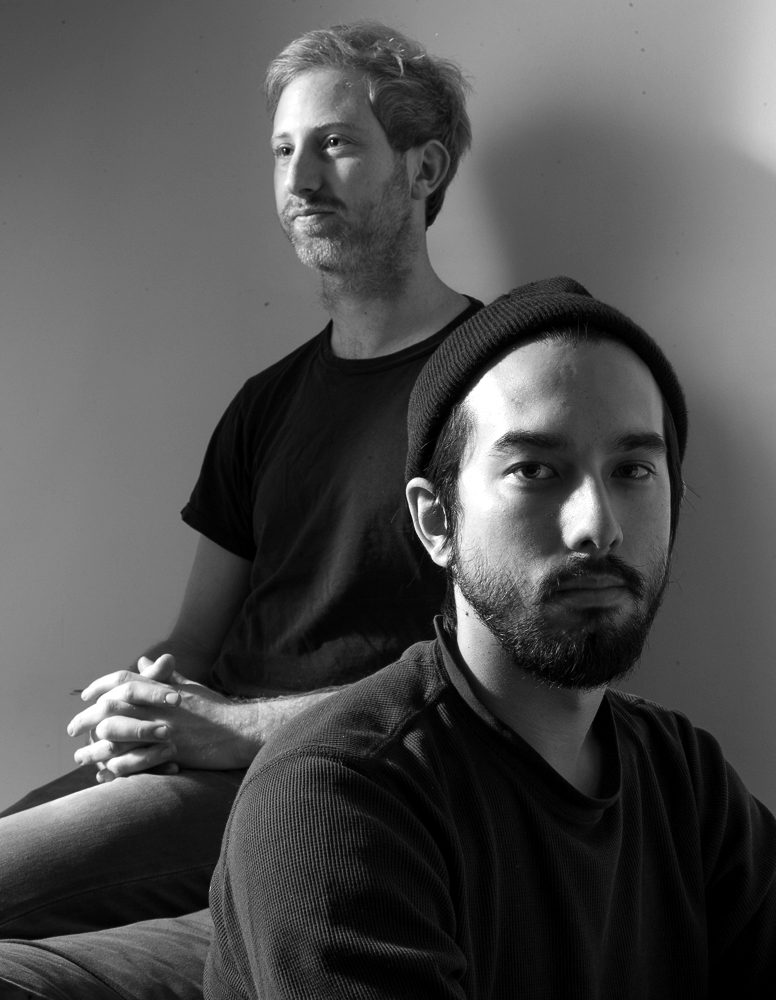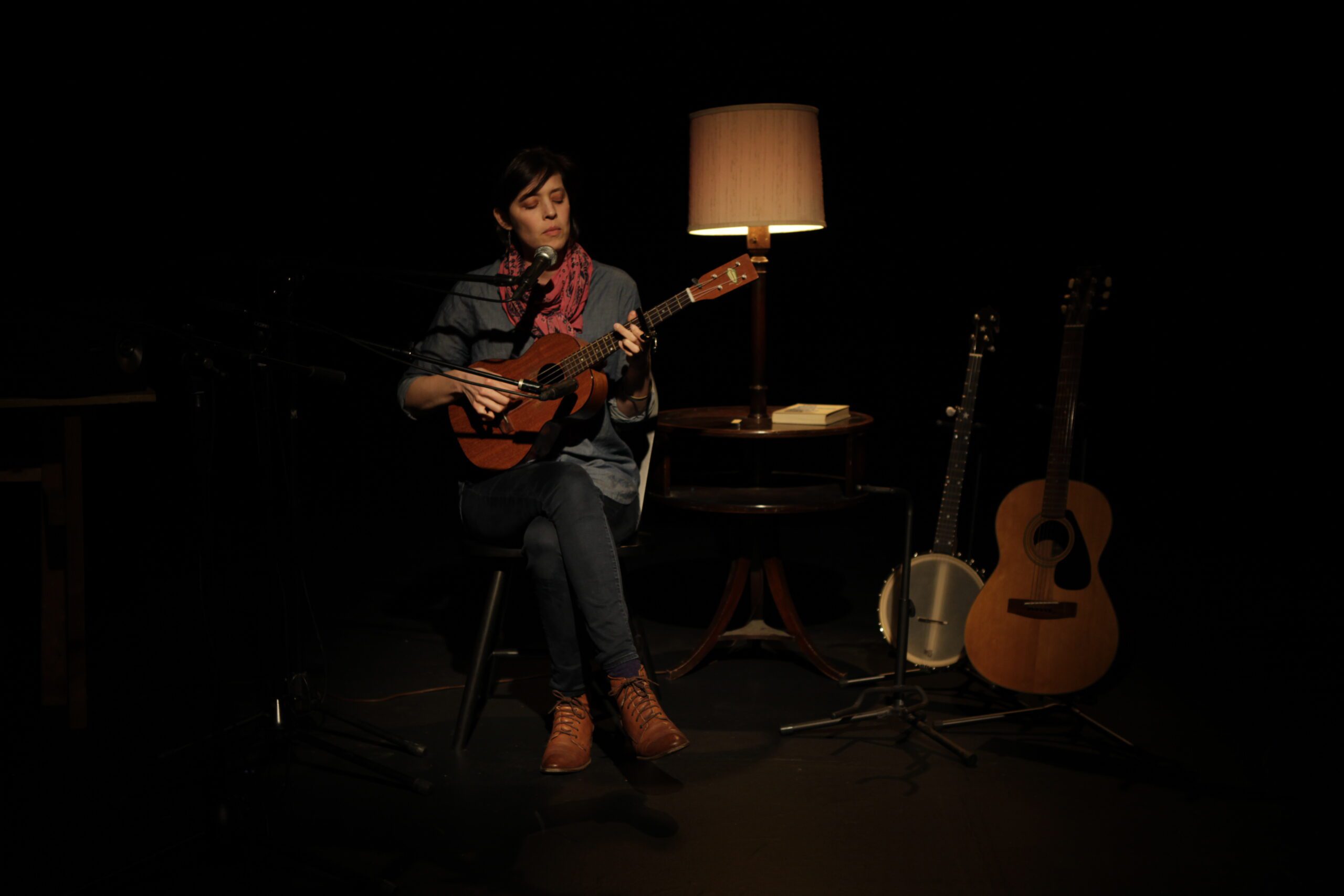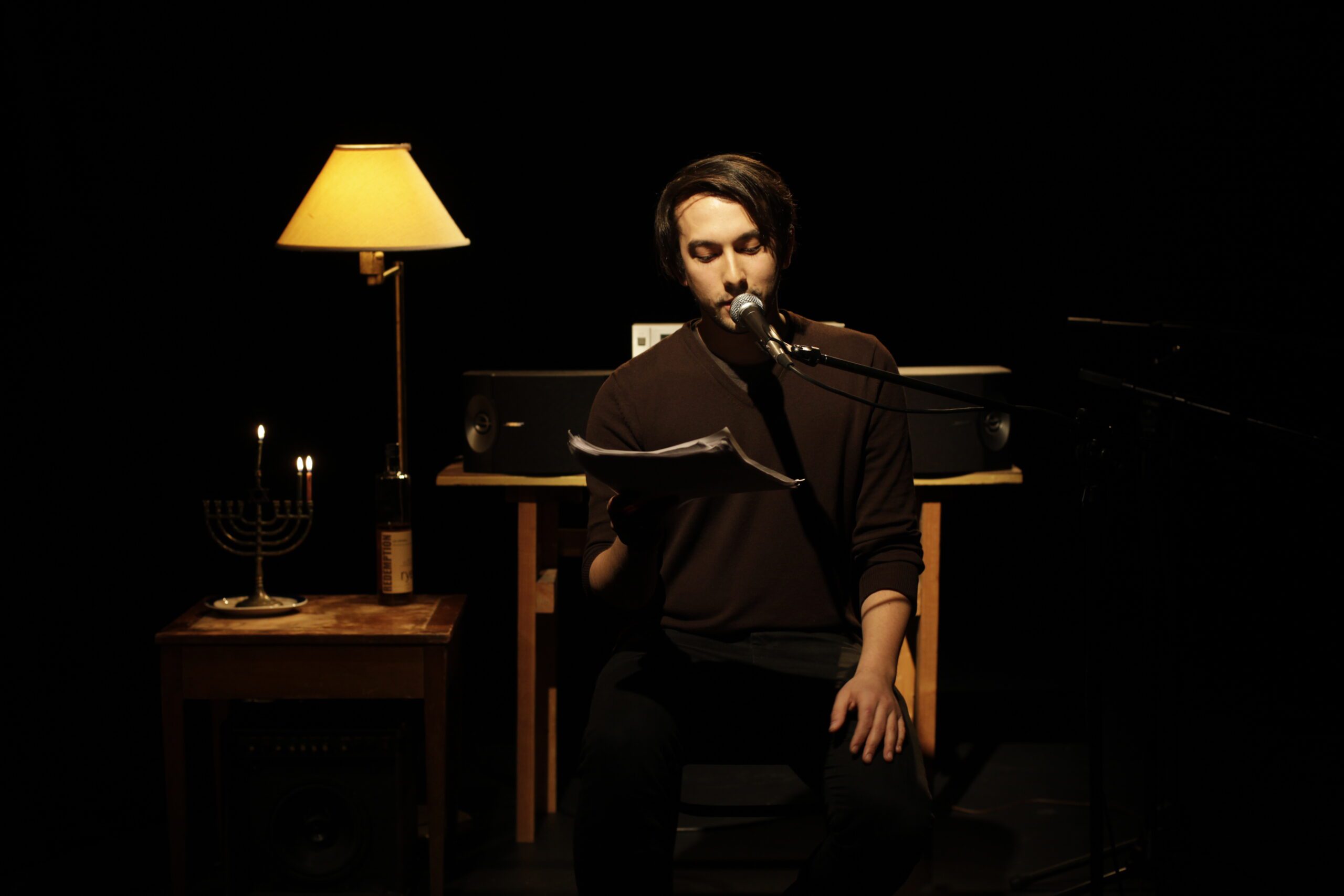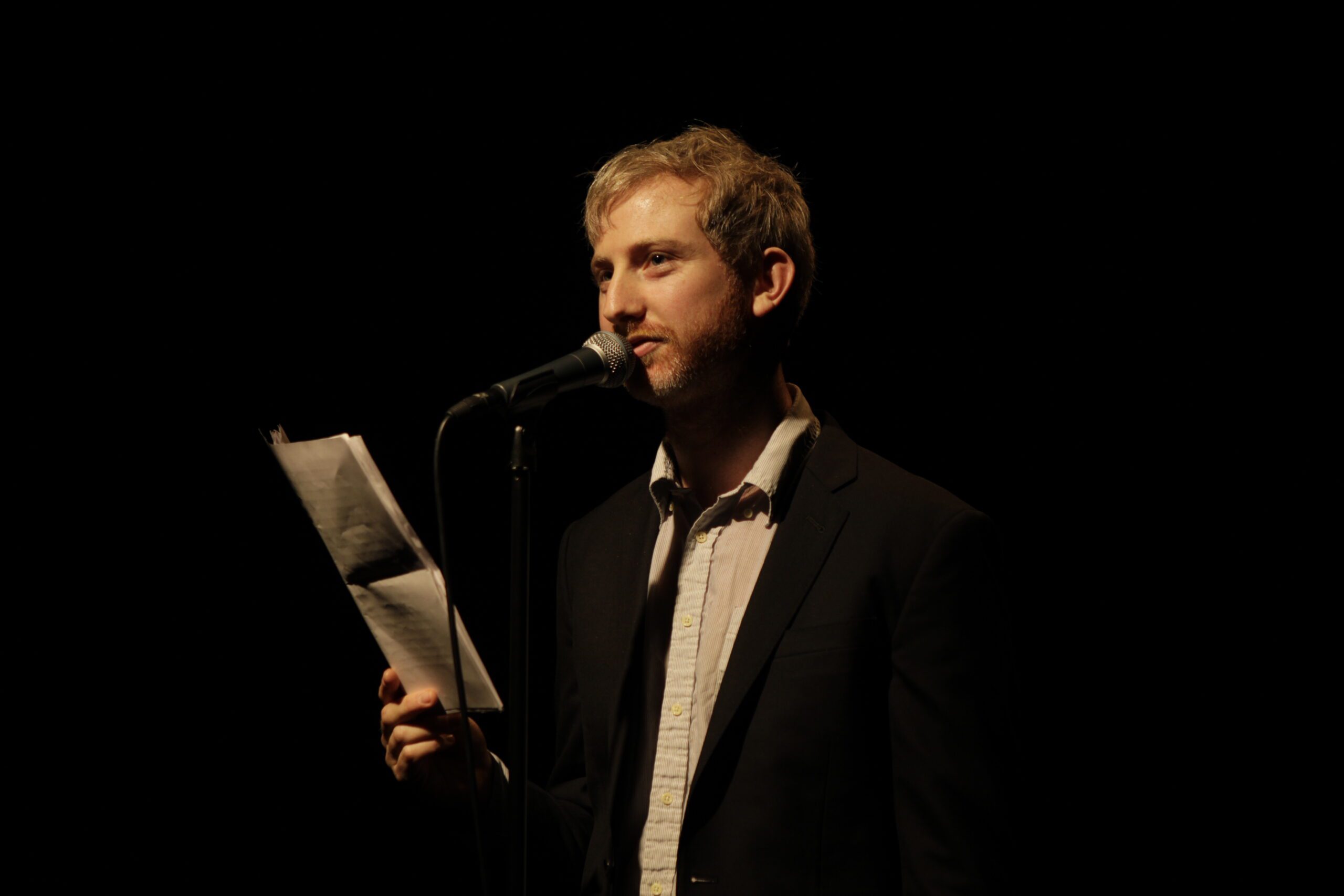
Philadelphia and Other Stories has the effect of beginning before it actually does. There’s the faint Americana and blues music that hums quietly from a stereo, situated between a wooden table and a period lamp, as guests arrive; there’s the ukulele and acoustic guitars that sit on their stands, and the shadows that preside before the three microphones set at equal distances from each other. And so jumpstarts this overbearing expectation that the performers are already there before they indeed enter, and that the scene (bearing a resemblance to a living room, albeit a dark one) is one we have encountered before. What is wonderfully original about Paul Rome and Roarke Menzies’s Philadelphia and Other Stories is how close to expectation we are led, and how quickly we are deterred from it. Their revolving interplay of fictional stories and music that appeared at the Bushwick Starr from December 18-20th does not hide the fact that it is a performance—and assiduously rehearsed at that—but one that uses staging and literary tropes to encourage a new type of listening and viewing appreciation, a storytelling mythology that can mislead as much as it can purport the truth.
Rome, who has written all of the text, and Menzies, a musician, singer, and composer who has provided the score, are a formidable pair that have worked together since 2010,  and Philadelphia and Other Stories, their newest collaboration, successfully synthesizes writer, reader, performer, and musician, striving to blur the line between these roles. The two-act performance that alternates between narrative tales, read and performed by Rome, Menzies, and Katie Schottland, and live music by David Kammerer and Katie Mullins, offers the premise that one who reads the piece may not be the one who wrote it, and this gift-giving of sorts layers the performance with an unhindered type of believability, in that the storyteller has injected his or her own flare, cadence, and self-consciousness to the overall method.
and Philadelphia and Other Stories, their newest collaboration, successfully synthesizes writer, reader, performer, and musician, striving to blur the line between these roles. The two-act performance that alternates between narrative tales, read and performed by Rome, Menzies, and Katie Schottland, and live music by David Kammerer and Katie Mullins, offers the premise that one who reads the piece may not be the one who wrote it, and this gift-giving of sorts layers the performance with an unhindered type of believability, in that the storyteller has injected his or her own flare, cadence, and self-consciousness to the overall method.
In the title story, “Philadelphia,” Menzies’s narrator describes a trip taken with a recent girlfriend to view the Swiss-made automaton machine at the Franklin Institute in Philadelphia, an actual, scarily enough, machine that churns out poems at the drop of a dime. But like many respectable stories, this is not about the destination, but the journey—one that follows a couple through metaphoric speed bumps, second-guesses, flashbacks, and pop music, the latter used as a tool to track and record this relationship. As it turns out, Rome and Menzies are huge fans of pop music (who can blame them?), and even Menzies’s sensory, atmospheric music that cuts through the text is derived from pop sounds, effects he has engineered through his own musical and vocal sensibilities.
“Pop music is one of the ways we’re socialized into what love is or what love can be,” Menzies told me, and it seems that pop music, and the stories themselves, are complimentary to one another, used to explore self-mythology en route to bigger discussions about love and relationships. Menzies continued, “Pop songs are like contemporary myths, on this huge platform, where they are ubiquitous. Every single person knows these songs, but every person has their own relationship to them.” This is precisely how Rome’s text functions in the performance, too, as a way of retelling these memories using a present-tense form that once again  distorts and changes their truths and immediacy.
distorts and changes their truths and immediacy.
In the second story, “Clermont,” a young woman, previously mentioned in the first story, leaves to study abroad in France, eventually taking up home with a Frenchman, Antoine, and his mother, while she contemplates her immediate and long-term future. It is a story everyone’s either told or heard before: a young and impressionable girl wishing to shake her American cloak, a passionate romance, a lazy boyfriend, all clinging on to love and companionship as it dissipates before our eyes. But it is this familiar set-up, as in pop songs, that integrate these stories into a realm of modern mythmaking.
“One of the big themes of this project is personal mythology,” Rome says, “the things that happen to you and the memories that become larger-than-life formative life stories that shape your world view.” So deep and personal do these mythologies run that when we get to “Scarsdale,” which follows our narrator, a self-described atheist Jew, returning home for a Jewish holiday (he cannot remember which one), we are building upon his previous admissions and also using the current one to inform our perception of him. Whether Rome has used one narrator and followed this long litany of memory and biography or has used many narrators as a stand-in for numerous kinds of relationships is not really the point; what matters is how close all these versions get to teaching us about ourselves. When the first act concludes with “Bellows Falls,”  a grainy cassette-tape recording of a man explaining to an undisclosed listener why he could not catch the train to see his beloved, we, too, become that listener, frozen in time and forced to encounter these deeply rooted justifications for self and other—and the tape cassette, anachronistic as it may be, firms up the nostalgia that the stories have been building to.
a grainy cassette-tape recording of a man explaining to an undisclosed listener why he could not catch the train to see his beloved, we, too, become that listener, frozen in time and forced to encounter these deeply rooted justifications for self and other—and the tape cassette, anachronistic as it may be, firms up the nostalgia that the stories have been building to.
For Rome, a gentle and deeply introspective writer who derives inspiration from old-time radio broadcasts, nostalgia is nestled in the in-between, a transitory moment (like a car ride or a radio sound bite) that finds pleasure in the extracting the liminal for all it is worth. “Philadelphia is so interesting,” he says. “You forget how close you are to New York, right? It’s a mere two-hour drive, and the experience of making that trip with someone can still feel like a real journey. Not even spending the night, but going and coming back. The [title] story starts and ends in New Jersey, a sort of intermediate place, but builds upon the stories and sensations that this trip evokes.” The episodic nature of the stories, the jumping back and forth, the catapulting and recapturing, has the effect of Roman à clef and stream of conscious, but Rome and Menzies have paired a lot of the writing down, ensuring that every sentence counts. Take one of the first sections from the title story, in which words and lyrics are used interchangeably to provide unbroken context and texture:
I was awoken that morning by the sound of a rooster. It was startling and disorienting. It seemed improbable. Such a familiar, nostalgic sound. But from where? Or when? I wondered if maybe a part of me might still be in some kind of dream. Until it came to me: Ashley lived in a ground floor apartment that shared a backyard with a Guyanese man who kept a rooster and some chickens in a wooden coop. And it was her bed I was lying in, the back of her head I was looking at, resting on the pillow in front of me. When I said her name, she rolled over and swung an arm over my chest.
The roosters continued. And I thought of that Dylan line.
“When the rooster crows at the break of dawn
Look out your window and I’ll be gone”Certain songs, once they’re in there, they’re so hard to get out.
Rome puts his stories in the fictional realm, but does not deny their roots in the autobiographical, a style that triggers their empathy and the urgency by which the narrator relays these interstitial memories. All of the stories, save for “Orpheus,” a retelling of the classical myth and “Indiana,” where the narrator is intersected by an omniscient second-person, are told in first-person form, which coat the performance with a personal fatalism, a belief that no matter what happens, the future will perpetually exist in digression and excursion, literal and metaphoric. “Orpheus” is literally commenting upon the performance, providing a framework and criticism about how mythology, personal or humanistic, works. “Indiana,” which has Rome and Menzies sharing the stage (Rome standing shrouded in white light; Menzies seated, as if still in his car) beautifully tries to offer closure to the car journey (now they’re in Indiana), with Rome telling Menzies’s narrator:
and “Indiana,” where the narrator is intersected by an omniscient second-person, are told in first-person form, which coat the performance with a personal fatalism, a belief that no matter what happens, the future will perpetually exist in digression and excursion, literal and metaphoric. “Orpheus” is literally commenting upon the performance, providing a framework and criticism about how mythology, personal or humanistic, works. “Indiana,” which has Rome and Menzies sharing the stage (Rome standing shrouded in white light; Menzies seated, as if still in his car) beautifully tries to offer closure to the car journey (now they’re in Indiana), with Rome telling Menzies’s narrator:
The two of you also tried, in those first months, to cohabit, via phone, your day’s final time of transition: that of wakefulness into sleep. Sometimes, lying in separate beds, these talks had the unintended consequence of exasperating feelings of loneliness. Without warning, a late-night discussion could turn flat or become strained…But more often you thrived on the intimacy of these talks, on allowing yourself to be vulnerable with another, and on the playful madness of your associations, as hours past, and your voices softened and your minds settled further into the darkness of sleep.
Menzies’s cadence is slow, dripping, confessional—his voice quiet and sometimes shaky; Rome’s is deeper, seemingly wiser, forceful, and this juxtaposition, combined with the lighting and symphonic music makes for an emotional closing, one that finds you still hearing their voices minutes after the lights finally turn back on. There are the characters that stay with you, too: our narrator, as well as Megan, Ashley, Amanda, and the folksier musical interludes that come between the readings, as if providing a more traditional Americana-type soundtrack to our narrators’ pop sensibilities. The blending of styles and moods is what Rome and Menzies have spent countless time perfecting—every lighting sequence, dynamic, staging set-up, phrasing— they are all there to usher in a total and complete picture of a relationship, and to step back from this relationship, to recall and remember.
they are all there to usher in a total and complete picture of a relationship, and to step back from this relationship, to recall and remember.
Menzies reminds me again of the automaton at the Franklin Institute in Philadelphia, as if rehashing the symbol of the performance: “All the poems and drawings are coming from this little disk under the axel of the robot and they are sort of pre-programmed, like there’s this predestined notion, similar to the Greek notion of fate in Orpheus. So are all these failed relationships running off a failed version of love?” Which, in a way, is what Rome and Menzies are trying to ask themselves, too: Does art imitate life or does life imitate art?
“I enjoy that confusion,” Rome says of this question, and of the performance choices themselves, namely Menzies and Schottland reading some of his texts. And for the audience, too, this confusion is necessary. It solidifies how stories are passed down, literally from one person to the next, and how honest they appear once they come out. Rome, apart from Menzies and a few close friends, has not shared these stories with anyone else before, and there is the effect that this is the first time all the performers are uttering them too, exchanging bombast for reserve, clinging on to every word, and taking advantage of the expectation that keeps us there in the first place.
***
Feature photo poster art © Benjamin Lehn.
Photo of Paul Rome and Roarke Menzies © Joshua Simpson.
Photos of production © Juliana Cerqueira Leite.




